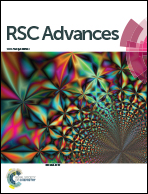Hydrothermal synthesis of Co–ZnO nanowire array and its application as piezo-driven self-powered humidity sensor with high sensitivity and repeatability
Abstract
A high sensitive and repeatable self-powered humidity sensor has been realized from Co-doped ZnO nanowires (NWs). The piezoelectric output of the device acts not only as a power source, but also as a response signal to the relative humidity (RH) in the environment. When the relative humidity is 70% RH at room temperature, the piezoelectric output voltage of the humidity sensor under compressive force decreases from 1.004 (at 20% RH) to 0.181 V. The sensitivity of self-powered humidity sensing based on Co-doped ZnO nanoarrays is much higher than that of undoped ZnO nanoarrays. The device exhibits good repeatability for humidity detection, and the response maintains ∼90% after one month. Such a high performance can be attributed to the piezo-surface coupling effect of the nanocomposites and more active sites introduced by the Co dopants. Our study can stimulate a research trend on exploring composite materials for piezo-gas sensing.


 Please wait while we load your content...
Please wait while we load your content...